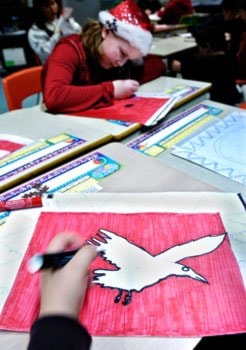Walking into Elijah Smith Elementary you can immediately tell that there is something unique about the school.
The high-vaulted ceilings are filled with skylights allowing natural light to filtre in and reflect off of beautiful wooden posts and beams.
“It’s not your normal school design,” said the school’s principal John Wright as he pointed out each wing of the school, named after the artwork that hangs from the ceiling.
The younger grades, for example, are in the butterfly wing.
During the tour, Wright greeted each student by name and jibed some of them about which hockey teams they support.
Sitting down in the library, located in the centre of the school, Wright and vice-principal Jan Wallace explained what really makes their school special.
Elijah Smith is running on an “open-school” concept, which Wright first helped implement at Whitehorse Elementary.
The school opens at 7 a.m. and kids can come in as early as they want.
A nutritious breakfast is available and there are more activities available during lunch and after school.
“It’s based on the idea of making the school more child centered,” said Wright.
“What that does is bring the families in too, because if the school is a welcoming place for kids it’ll be a welcoming place for parents and grandparents as well.”
Half the school’s students are from aboriginal families, with parents who often had a negative experience at school, he said.
The school tries to turn that around by opening itself to the community.
“It takes a long time to get people to feel confident and trusting about schools,” said Wright.
“That’s not just for First Nations; a surprising amount of people didn’t have a good experience at school, and they’re quite wary about what we’re doing here.”
All Whitehorse schools have some kind of a food program and many are running a form of the open-school concept.
And the other schools are seeing similar success with the program.
“Once you open your doors people are going to come in,” said Wright.
“What’s difficult is convincing parents that it’s OK for them to come in too.”
Under the open-school concept, parents and grandparents are invited to wander in at any time.
They can help out in classrooms, visit or simply wait in the school’s striking foyer.
“In the mornings many parents come in to read with their children in the hallways,” added Wallace.
“We’re getting a lot more grandparents in visiting recently, which is very nice to see.”
With parents coming and going freely, you’d think that there would be trouble with security.
But visitors aren’t even required to report to the front desk.
“Think about it, if a person wants to do something harmful in a school would they report to the front desk?” said Wright.
“We know all of our parents so if a teacher sees someone that they don’t know they’ll politely ask them if they need any help.”
The concept creates a more relaxed atmosphere.
In 2004, the school participated in a national study called Sharing Our Success, which examined schools with significant aboriginal populations.
The study found that as a result of the open-school program the kids had made progress in Yukon achievement test scores.
“But I think it’s a very subjective thing — not something you can easily quantify,” said Wright.
“Anytime a child is able to get to school on time and have a nutritious breakfast its bound to have a positive effect.”
A month ago, Wright and Wallace attended a national conference in Winnipeg to demonstrate methods to help aboriginal learners succeed.
The conference showcased 20 different schools that had been part of two Sharing our Success studies.
The event was a first in Canada.
“We were amazed,” said Wallace.
“Each school is quite unique, but we’re all dealing with the same problems and difficulties.”
“Everyone’s on the same page, as far as nurturing kids,” said Wright.
“We need to make sure that their well-being is looked after as well as their academic success.”
Most of the schools were exclusively aboriginal.
Elijah Smith was one of the very few with a significantly mixed population.
“It’s 50/50 and it’s always been 50/50; half of our teachers are First Nations as well,” said Wright.
“It brings two worlds together.”
There’s a heavy emphasis on First Nations culture in the school programming.
The school offers Southern Tutchone Language Classes, traditional dance groups, and cultural weeks, which everyone participates in.
The Grade 7 students even go on a bison hunt, a fact that shocked Wright and Wallace’s colleagues down south.
The kids take a hunting safety course and though they don’t shoot the animal themselves they do get to butcher it.
“The First Nations community needs to be able to see themselves in the school,” said Wright
“And for non-First Nations students, the school provides a richness in culture that students wouldn’t be able to find anywhere else.
“The premise here is that anyone who goes to school in the Yukon should know about First Nations history and culture, whether their ancestry is First Nations or not.”
